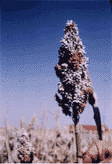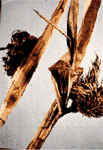Reports on Plant Diseases |
RPD No. 208 - Sorghum Smuts
|
December 1990
|
[ Covered Kernel Smut ][ Loose
Kernel Smut ][ Head Smut ][ Control ]
|
Smuts are one of the most important diseases of sorghum in much
of the Midwest, especially where untreated seed is planted. Damage
is confined almost entirely to the head or panicle, reducing both
the grain yield and forage value. Three sorghum smuts are common
in the Midwest: covered kernel smut, loose kernel smut, and head
smut. Each one is caused by a different species of the fungus Sporisorium.
Covered Kernel Smut
Covered kernel smut, caused by the fungus Sporisorium sorghi (synonym
Sphacelotheca sorghi) attacks all groups of sorghums, including
johnsongrass. Covered kernel smut is the most common disease of
sorghum in Illinois and other states where farmers plant untreated
seed. Usually, all of the kernels in a smutted head are destroyed
and replaced by dark brown, powdery masses of smut spores (teliospores
or chlamydospores) covered with a tough, grayish white or brown
membrane (Figure 1). The membrane usually ruptures at harvest time.
The infected kernels (smut sori) break, and the microscopic spores
adhere to the surface of healthy seeds where they overwinter. Only
seeedborne spores cause infection. Smut sori are generally smooth;
oval, conical or cylindrical; and vary in size from those small
enough to be concealed by the glumes to those over one cm long.
They may be white, gray, or brown.
When a smut-infested kernel is planted, the teliospores (mostly
4 to 7 microns in diameter) germinate along with the seed forming
a 4-celled promycelium (epibasidium) bearing lateral sporidia (Figure
2). The sporidia germinate and infect the developing sorghum seedling.
(Sometimes the teliospores germinate directly by producing germ
tubes). Once inside the seedling, the fungus grows systemically,
apparently without damaging the plant until heading. At that time,
the teliospores replace kernels and are surrounded by a membrane.
At maturity, the membrane ruptures releasing the teliospores to
contaminate seed or soil. Soilborne teliospores are not considered
important in infecting seedlings. The incidence of smut decreases
when seed is planted in progressively warmer, wet soils that are
60 to 90 F (15.5 to 32 C). Several distinct physiologic races of
the covered smut fungus are known.
Back to Top |

Figure
1. Covered kernel smut on sorghum.
|
|

Figure
2. Teliospores
of Sporisorium as they would appear under a high-power microscope.
Each spiny, dark teliospore has germinated to produce a 4-celled
promycelium that bears sporidia terminally and near the septa.
The sporidia may sprout to form secondary sporidia or may germinate
to form a germ tube that penetrates a sorghum seedling. (Drawing
by Lenore Gray.)
|
Loose Kernel Smut
Loose kernel smut, caused by the fungus Sporisorium cruentum (synonym
Sphacelotheca cruenta) is less widespread than covered kernel smut.
Loose kernel smut attacks all groups of sorghums, including johnsongrass,
although certain varieties in some groups are immune or highly
resistant. Sudangrass is usually not infected.
Normally, all kernels in an infected panicle are smutted. Partial
destruction is rare. Some kernels may be transformed into leafy
structures or escape infection completely. Individual kernels are
replaced by small smut galls (or sori) that are 2.5 cm or longer,
pointed and surrounded by a thin gray membrane. This membrane usually
ruptures when or soon after the panicle emerges from the boot (Figure
3B). Smutted panicles appear earlier than the remainder of the
crop and are more open than healthy panicles. The powdery, dark
brown to black spores (teliospores) are soon blown away, leaving
a long, black, pointed, conical, often curved structure (columella)
in the center of what was the gall. Some smut spores (6 to 10 microns
in diameter) adhere to the surface of healthy kernels on neighboring
plants in the same field or ones nearby before and during harvest.
When such infested kernels are planted, the teliospores germinate
along with the seed by first forming a thick, usually 4-celled
promycelium bearing lateral sporidia (Figure 2). The sporidia germinate
and infect the developing sorghum seedling. Most infections, however,
result from the teliospores producing hyphae which penetrate young
seedlings before emergence. Seedling infection occurs over a wide
range of soil moisture and pH at a temperature of 68 to 77 F (20
to 25 C). The fungus continues to grow systemically within the
plant unobserved until heading, when the long, black, pointed smut
galls develop in place of normal kernels.
Unlike covered kernel smut, plants affected with loose kernel
smut are stunted, have thin stalks, and heads emerge earlier than
healthy plants. Abundant side branches (tillers) also may develop.
Occasionally, the tillers are smutted, while the primary head is
not.
Secondary infection may occur in loose kernel smut when spores
from a smutted head infect late-developing heads of healthy sorghum
plants, causing them to become smutted. Localized infection of
floral parts from airborne spores may occur.
Teliospores in the soil are not important in terms of infecting
seedlings. Several physiologic races of the loose kernel smut fungus
exist. The fungus is heterothallic and is able to hybridize with
both the covered kernel and head smut fungi, complicating the problem
of developing resistant hybrids.
Back to Top
|
Head Smut
Head smut caused by Sporisorium holci-sorghi (synonyms S. reilianum
and Sphacelotheca reiliana) is not so widespread and damaging in
the Midwest as the kernel smuts. Head smut attacks both corn and
sorghums, being more common on the latter. Separate physiologic
races occur on corn and on sorghums. Head smut has increased in
severity proportionately to intensive cultivation of susceptible
hybrids. Smutted plants also have weakened root systems and commonly
exhibit more severe stalk and root rots than smut-free plants.
Infection first appears when the young head, enclosed in the boot,
is usually completely replaced by a large smut gall covered by
a thick whitish membrane. The membrane soon ruptures, often before
the head emerges, exposing a mass of dark brown to black, powdery
teliospores intermingled with a network of long, thin, dark, broomlike
filaments of vascular tissue (Figure 4). The head may be totally
smutted with characteristic "witches' brooms," i.e.,
many small, rolled leaves protruding from the heads of suckers
at the nodes or joints of some sweet sorghums and sudangrass cultivars.
Some cultivars are dwarfed; others are stunted due to a lack of
elongation of the peduncle. Wind and rain quickly scatter the smut
spores to the soil and plant debris, where they live through the
winter.
Parts of an infected panicle not included in the smut gall or
sorus usually show a blasting (sterility) or proliferation of individual
florets. Smut galls may occasionally develop on the leaves and
stems in some cultivars of sweet sorghums and sundangrass.
When sorghum seed is planted the following spring, the smut spores
(9 to 14 microns in diameter) already in the soil germinate along
with the seed to form a 4-celled or branched promycelium that bears
sporidia terminally and near the septa. The sporidia may sprout
to form yeastlike secondary sporidia (Figure 2) or may germinate
to form a germ tube that penetrates meristematic tissue in the
sorghum seedling. Germination is highest in moist soil where the
temperature is 81 to 88 F (27 to 31 C). Like the kernel smuts,
head smut is not evident until heading time. The fungus develops
only in actively growing meristematic tissue. The smut spores also
may cling to the surface of sorghum seed, introducing the smut
fungus into the soil of fields not previously infested. Apparently,
seedborne spores are not important in causing infection.
Back to Top
|

Figure
3. Loose
kernel smut of sorghum: A, healthy head; B, head infected with
loose kernel smut–kernels have been replaced by smut masses
that have been largely blown away, leaving the prominent columellas.
(USDA photograph).
|

Figure
4. Head
smut (Sphacelotheca reilianum).
|
1. Covered and loose kernel smuts are easily and effectively
controlled by treating the seed with a protectant fungicide.
Seed treatment prevents introducing the head smut fungus into
uninfested fields. Fungicide seed treatment also improves and
stabilizes the stand when soil insects are not a problem. In
addition, it provides protection against seedling blight fungi
in the soil. Suggested fungicide for treating sorghum seed are
given in the current Illinois Pest Control Handbook. Essentially
all commercial sorghum seed is now treated by the seed processor.
2. Because there are a number of physiologic races of the three
sorghum smut fungi, which can also hybridize with one another,
it is extremely difficult to develop highly resistant or immune
hybrids, varieties or cultivars of sorgho (sweet sorghum), gurno,
feterita, hegari, kaffir, durra, and milo types of sorghum as
well as sudangrass and broomcorn. Check with your seed dealer
as to what sorghums have performed best in your area. Those varieties,
hybrids, and types of sorghum that are resistant to races of
covered kernel smut usually are resistant to races of loose kernel
smut. Head smut is most damaging to sorgho, durras, and hybrids
between these two sorghum groups, but progress in developing
disease resistant varieties has been made. Most sweet sorghum
varieties are highly resistant.
3. Where feasible, promptly remove and burn head smut galls
before the spores are scattered.
4. Since the head smut fungus may live in the soil for several
years grow sorghum in the same field only once in 4 years. Such
a rotation also helps to control other diseases that attack the
leaves, heads, stalks, and roots.
|
Back to Top
For further information concerning diseases of crucifers
and other vegetables, contact Mohammad Babadoost, Extension Specialist
in Fruit and Vegetable Diseases, Department of Crop Sciences, University
of Illinois at Urbana-Champaign.
University of Illinois Extension provides
equal opportunities in programs and employment.
|



